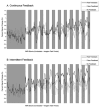Intermittent "real-time" fMRI feedback is superior to continuous presentation for a motor imagery task: a pilot study
- PMID: 20977537
- PMCID: PMC3070198
- DOI: 10.1111/j.1552-6569.2010.00529.x
Intermittent "real-time" fMRI feedback is superior to continuous presentation for a motor imagery task: a pilot study
Abstract
Background: Real-time functional MRI feedback (RTfMRIf) is a developing technique, with unanswered methodological questions. Given a delay of seconds between neural activity and the measurable hemodynamic response, one issue is the optimal method for presentation of neurofeedback to subjects. The primary objective of this preliminary study was to compare the methods of continuous and intermittent presentation of neural feedback on targeted brain activity.
Methods: Thirteen participants performed a motor imagery task and were instructed to increase activation in an individually defined region of left premotor cortex using RTfMRIf. The fMRI signal change was compared between real and false feedback for scans with either continuous or intermittent feedback presentation.
Results: More individuals were able to increase their fMRI signal with intermittent feedback, while some individuals had decreased signal with continuous feedback. The evaluation of feedback itself activated an extensive amount of brain regions, and false feedback resulted in brain activation outside of the individually defined region of interest.
Conclusions: As implemented in this study, intermittent presentation of feedback is more effective than continuous presentation in promoting self-modulation of brain activity. Furthermore, it appears that the process of evaluating feedback involves many brain regions that can be isolated using intermittent presentation.
Copyright © 2010 by the American Society of Neuroimaging.
Conflict of interest statement
Figures





Similar articles
-
Self-modulation of primary motor cortex activity with motor and motor imagery tasks using real-time fMRI-based neurofeedback.Neuroimage. 2012 Jan 16;59(2):917-25. doi: 10.1016/j.neuroimage.2011.07.035. Epub 2011 Jul 23. Neuroimage. 2012. PMID: 21803163 Free PMC article.
-
Performance of motor imagery brain-computer interface based on anodal transcranial direct current stimulation modulation.IEEE Trans Neural Syst Rehabil Eng. 2013 May;21(3):404-15. doi: 10.1109/TNSRE.2013.2249111. Epub 2013 Mar 7. IEEE Trans Neural Syst Rehabil Eng. 2013. PMID: 23475381 Clinical Trial.
-
Your mind's hand: motor imagery of pointing movements with different accuracy.Neuroimage. 2010 Feb 15;49(4):3239-47. doi: 10.1016/j.neuroimage.2009.11.038. Epub 2009 Dec 4. Neuroimage. 2010. PMID: 19948224
-
Continuous vs. intermittent neurofeedback to regulate auditory cortex activity of tinnitus patients using real-time fMRI - A pilot study.Neuroimage Clin. 2017 Jan 6;14:97-104. doi: 10.1016/j.nicl.2016.12.023. eCollection 2017. Neuroimage Clin. 2017. PMID: 28154796 Free PMC article. Clinical Trial.
-
EEG-Based Strategies to Detect Motor Imagery for Control and Rehabilitation.IEEE Trans Neural Syst Rehabil Eng. 2017 Apr;25(4):392-401. doi: 10.1109/TNSRE.2016.2646763. Epub 2016 Dec 30. IEEE Trans Neural Syst Rehabil Eng. 2017. PMID: 28055887 Review.
Cited by
-
Optimizing real time fMRI neurofeedback for therapeutic discovery and development.Neuroimage Clin. 2014 Jul 10;5:245-55. doi: 10.1016/j.nicl.2014.07.002. eCollection 2014. Neuroimage Clin. 2014. PMID: 25161891 Free PMC article. Review.
-
Functional Magnetic Resonance Imaging Neurofeedback-guided Motor Imagery Training and Motor Training for Parkinson's Disease: Randomized Trial.Front Behav Neurosci. 2016 Jun 8;10:111. doi: 10.3389/fnbeh.2016.00111. eCollection 2016. Front Behav Neurosci. 2016. PMID: 27375451 Free PMC article.
-
A feasibility study of goal-directed network-based real-time fMRI neurofeedback for anhedonic depression.Front Psychiatry. 2023 Dec 5;14:1253727. doi: 10.3389/fpsyt.2023.1253727. eCollection 2023. Front Psychiatry. 2023. PMID: 38125285 Free PMC article.
-
Insula as the Interface Between Body Awareness and Movement: A Neurofeedback-Guided Kinesthetic Motor Imagery Study in Parkinson's Disease.Front Hum Neurosci. 2018 Dec 7;12:496. doi: 10.3389/fnhum.2018.00496. eCollection 2018. Front Hum Neurosci. 2018. PMID: 30581383 Free PMC article.
-
fMRI Neurofeedback Training for Increasing Anterior Cingulate Cortex Activation in Adult Attention Deficit Hyperactivity Disorder. An Exploratory Randomized, Single-Blinded Study.PLoS One. 2017 Jan 26;12(1):e0170795. doi: 10.1371/journal.pone.0170795. eCollection 2017. PLoS One. 2017. PMID: 28125735 Free PMC article. Clinical Trial.
References
-
- Voyvodic JT. Real-time fMRI paradigm control, physiology, and behavior combined with near real-time statistical analysis. Neuroimage. 1999;10(2):91–106. - PubMed
-
- Bagarinao E, Nakai T, Tanaka Y. Real-time functional MRI: development and emerging applications. Magn Reson Med Sci. 2006;5(3):157–65. - PubMed
-
- Weiskopf N, et al. Real-time functional magnetic resonance imaging: methods and applications. Magn Reson Imaging. 2007;25(6):989–1003. - PubMed
-
- deCharms RC. Applications of real-time fMRI. Nat Rev Neurosci. 2008;9(9):720–9. - PubMed
-
- Birbaumer N, et al. Neurofeedback and brain-computer interface clinical applications. Int Rev Neurobiol. 2009;86:107–17. - PubMed
Publication types
MeSH terms
Grants and funding
LinkOut - more resources
Full Text Sources
Medical
Research Materials

